Performance Improvement of Hydrofoil with Biological Characteristics: Tail Fin of a Whale
Abstract
:1. Introduction
2. Model
2.1. Calculation Model
2.2. Independence of the Number of Grids and Reliability Verification
3. Results and Analysis
3.1. Influence of Flap Angle (FA) on Hydrodynamic Performance of Hydrofoil
3.2. Influence of Flap Length (FL) on Hydrodynamic Performance of Hydrofoil
3.3. Influence of Flap on Hydrodynamic Performance of Hydrofoil at Different REYNOLDS Numbers
4. Conclusions
- By comparing the vector diagram of the PIV experiment with the trace diagram of CFD, it is found that the size and position of the vortex measured in the experiment are close to that obtained by CFD, which shows that the simulation has high reliability.
- By comparing the streamline diagrams of AOA = 9°, AOA = 12°, and AOA = 15°, it is found that when AOA = 9°, partial flow separation occurs at the tail of the hydrofoil; With the increase of the angle of attack (AOA = 12°), the hydrofoil appears complete flow separation, the hydrofoil stalls and the lift coefficient decreases; As the angle of attack continues to increase (AOA = 15°), the hydrofoil appears double separation vortex. At this time, the hydrofoil has a deep stall effect and the lift increases again.
- By analyzing the influence of flap angle (FA) on the hydrodynamic performance of hydrofoil, it is found that the hydrofoil with clockwise flap can have better hydrodynamic characteristics at a small angle of attack (AOA ≤ 6°) under the same Reynolds number and flap length (FL). Although the counterclockwise flap will reduce the hydrodynamic characteristics of the hydrofoil, it will increase the critical stall angle to improve the navigation stability of the hydrofoil.
- By analyzing the influence of flap length (FL) on the hydrofoil hydrodynamics, it is found that hydrofoil with flap has better hydrodynamic characteristics at a small angle of attack(AOA ≤ 6°), and hydrofoil with a short flap has a better angle of attack characteristics, which can maintain a higher hydrodynamic performance in a wider range of angle of attack.
- By analyzing the influence of different Reynolds numbers on the hydrodynamic performance of hydrofoil, it is found that under the same small angle of attack, the hydrofoil with a short flap has better Reynolds number characteristics and can maintain a higher hydrodynamic performance in a wider range of Reynolds numbers.
- Compared with the original hydrofoil, the short flap improves the hydrodynamic performance of the hydrofoil at a small angle of attack. The hydrofoil can also be applied to various working conditions by adjusting the angle of the flap. Therefore, when designing the hydrofoil, a rotatable short flap can be added at the tail of the hydrofoil to enable the hydrofoil to navigate in a more complex flow environment.
Author Contributions
Funding
Institutional Review Board Statement
Informed Consent Statement
Data Availability Statement
Conflicts of Interest
References
- Nachtane, M.; Tarfaoui, M.; Goda, I.; Rouway, M. A review on the technologies, design considerations and numerical models of tidal current turbines. Renew. Energy 2020, 157, 1274–1288. [Google Scholar] [CrossRef]
- Xu, W.; Xu, G.; Duan, W.; Song, Z.; Lei, J. Experimental and numerical study of a hydrokinetic turbine based on tandem flapping hydrofoils. Energy 2019, 174, 375–385. [Google Scholar] [CrossRef]
- Hao, W.; Li, C. Performance improvement of adaptive flap on flow separation control and its effect on VAWT. Energy 2020, 213, 118809. [Google Scholar] [CrossRef]
- Yan, H.; Su, X.; Zhang, H.; Hang, J.; Zhou, L.; Liu, Z.; Wang, Z. Design approach and hydrodynamic characteristics of a novel bionic airfoil. Ocean Eng. 2020, 216, 108076. [Google Scholar] [CrossRef]
- Velte, C.M.; Hansen, M. Investigation of flow behind vortex generators by stereo particle image velocimetry on a thick airfoil near stall. Wind Energy 2013, 16, 775–785. [Google Scholar] [CrossRef]
- Hussain, S.; Liu, J.; Wang, L.; Sundén, B. Suppression of endwall heat transfer in the junction region with a symmetric airfoil by a vortex generator pair. Int. J. Therm. Sci. 2019, 136, 135–147. [Google Scholar] [CrossRef]
- Itsariyapinyo, P.; Sharma, R.N. Large Eddy simulation of a NACA0015 circulation control airfoil using synthetic jets. Aerosp. Sci. Technol. 2018, 82–83, 545–556. [Google Scholar] [CrossRef] [Green Version]
- Tousi, N.M.; Coma, M.; Bergadà, J.M.; Pons-Prats, J.; Mellibovsky, F.; Bugeda, G. Active Flow Control Optimisation on SD7003 Airfoil at Pre and Post-stall Angles of Attack using Synthetic Jets. Appl. Math. Model. 2021, 98, 435–464. [Google Scholar] [CrossRef]
- Somers, D.M. An Exploratory Investigation of a Slotted, Natural-Laminar-Flow Airfoil; Langley Research Center: Hampton, VA, USA, 2012. [Google Scholar]
- Coder, J.G.; Dan, M.S. Design of a slotted, natural-laminar-flow airfoil for commercial transport applications. Aerosp. Sci. Technol. 2020, 106, 106217. [Google Scholar] [CrossRef]
- Xiao, Q.; Zhu, Q. A review on flow energy harvesters based on flapping foils. J. Fluid Struct. 2014, 46, 174–191. [Google Scholar] [CrossRef]
- Young, J.; Lai, J.C.S.; Platzer, M.F. A review of progress and challenges in flapping foil power generation. Prog. Aerosp. Sci. 2014, 67, 2–28. [Google Scholar] [CrossRef]
- Triantafyllou, M.S.; Techet, A.H.; Hover, F.S. Review of Experimental Work in Biomimetic Foils. IEEE J. Ocean. Eng. 2004, 29, 585–594. [Google Scholar] [CrossRef] [Green Version]
- Johari, H.; Henoch, C.; Custodio, D.; Levshin, A. Effects of Leading-Edge Protuberances on Airfoil Performance. AIAA J. 2007, 45, 2634–2642. [Google Scholar] [CrossRef]
- Rostamzadeh, N.; Hansen, K.L.; Kelso, R.M.; Dally, B.B. The formation mechanism and impact of streamwise vortices on NACA 0021 airfoil’s performance with undulating leading edge modification. Phys. Fluids 2014, 26, 51–60. [Google Scholar] [CrossRef]
- Skillen, A.; Revell, A.; Pinelli, A.; Piomelli, U.; Favier, J. Flow over a Wing with Leading-Edge Undulations. AIAA J. 2014, 53, 464–472. [Google Scholar] [CrossRef]
- Cai, C.; Zuo, Z.; Liu, S. Numerical investigations of hydrodynamic performance of hydrofoils with leading-edge protuberances. Adv. Mech. Eng. 2015, 7. [Google Scholar] [CrossRef] [Green Version]
- Chae, E.J.; Akcabay, D.T.; Lelong, A.; Astolfi, J.A.; Young, Y.L. Numerical and experimental investigation of natural flow-induced vibrations of flexible hydrofoils. Phys. Fluids 2016, 28, 075102. [Google Scholar] [CrossRef]
- Ni, Z.; Dhanak, M.; Su, T.C. Performance of a slotted hydrofoil operating close to a free surface over a range of angles of attack. Ocean Eng. 2019, 188, 106296. [Google Scholar] [CrossRef]
- Belamadi, R.; Djemili, A.; Ilinca, A.; Mdouki, R. Aerodynamic performance analysis of slotted airfoils for application to wind turbine blades. J. Wind Eng. Ind. Aerodyn. 2016, 151, 79–99. [Google Scholar] [CrossRef]
- Wilga, C.D.; Lauder, G.V. Biomechanics—Hydrodynamic function of the shark’s tail. Nature 2004, 430, 850. [Google Scholar] [CrossRef]
- Lauder, G.V.; Nauen, J.C.; Drucker, E.G. Experimental Hydrodynamics and Evolution: Function of Median Fins in Ray-finned Fishes. Integr. Comp. Biol. 2002, 42, 1009–1017. [Google Scholar] [CrossRef] [PubMed] [Green Version]
- Sfakiotakis, M.; Lane, D.M.; Davies, J. Review of fish swimming modes for aquatic locomotion. IEEE J. Ocean. Eng. 1999, 24, 237–252. [Google Scholar] [CrossRef] [Green Version]
- Karbasian, H.R.; Moshizi, S.A.; Maghrebi, M.J. Dynamic Stall Analysis of S809 Pitching Airfoil in Unsteady Free Stream Velocity. J. Mech. 2016, 32, 227–235. [Google Scholar] [CrossRef] [Green Version]
- Karbasian, H.R.; Esfahani, J.A.; Barati, E. Effect of acceleration on dynamic stall of airfoil in unsteady operating conditions. Wind Energy 2014, 19, 17–33. [Google Scholar] [CrossRef]
- Wang, S.; Ingham, D.B.; Ma, L.; Pourkashanian, M.; Tao, Z. Numerical investigations on dynamic stall of low Reynolds number flow around oscillating airfoils. Comput. Fluids 2010, 39, 1529–1541. [Google Scholar] [CrossRef]

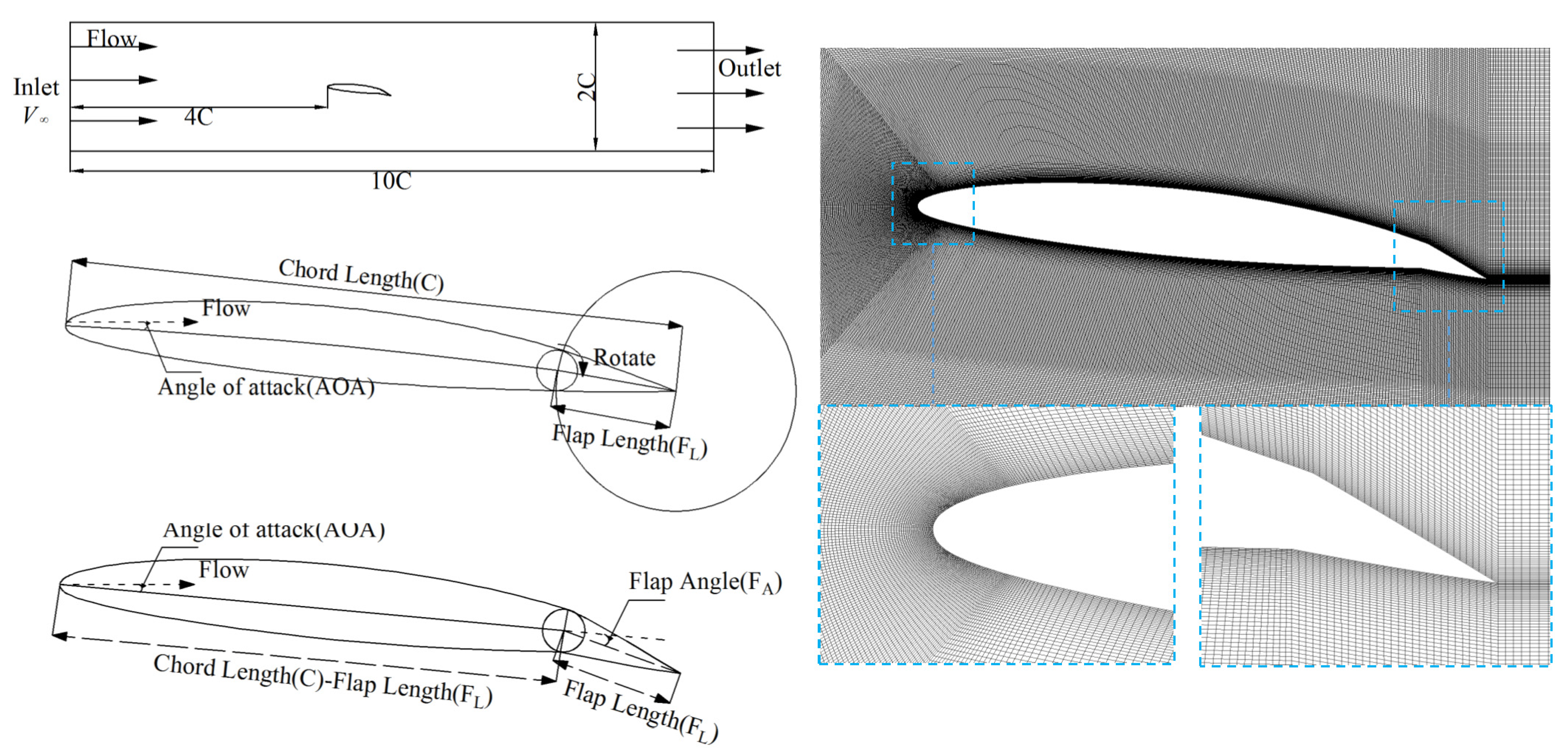
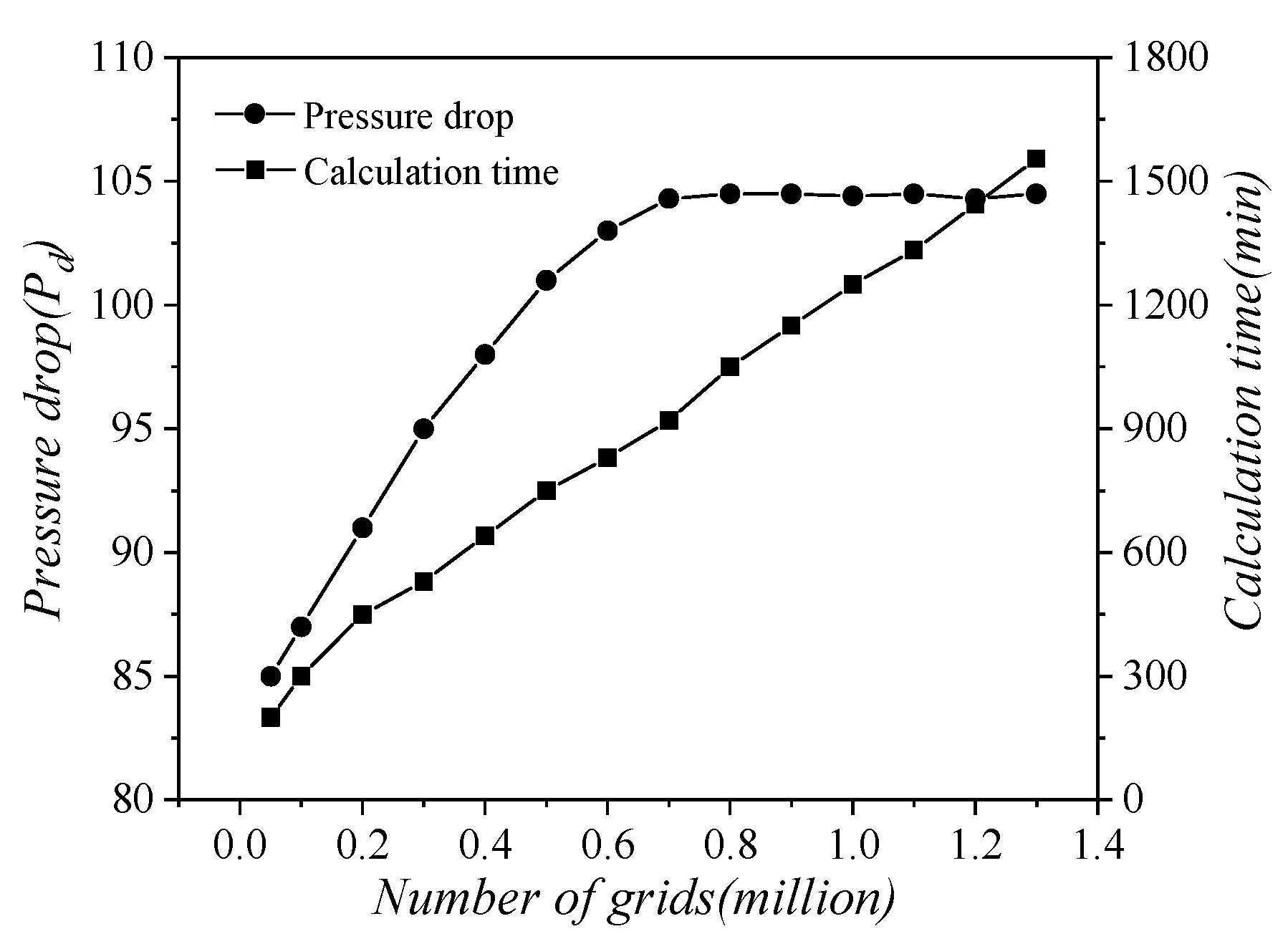

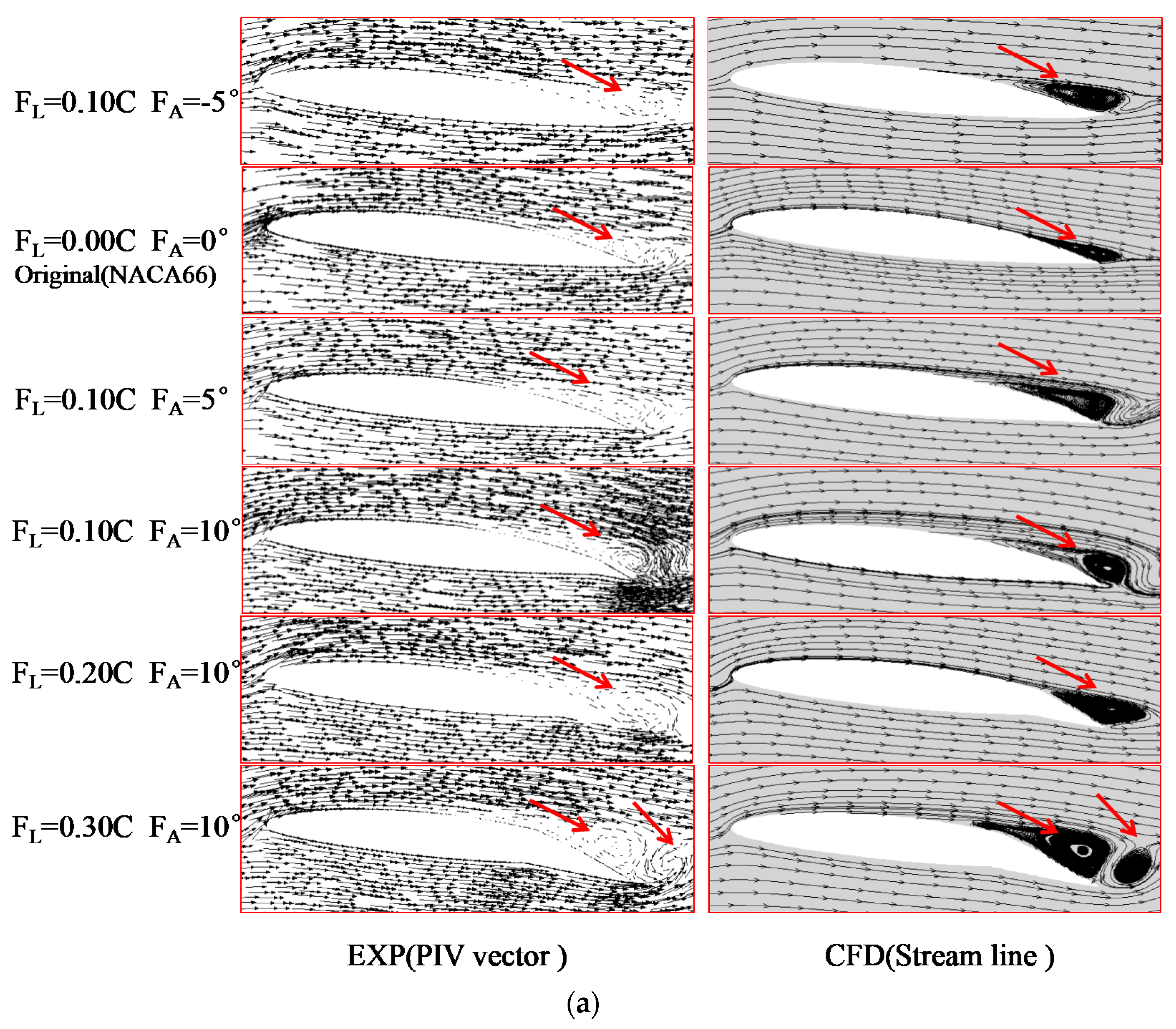
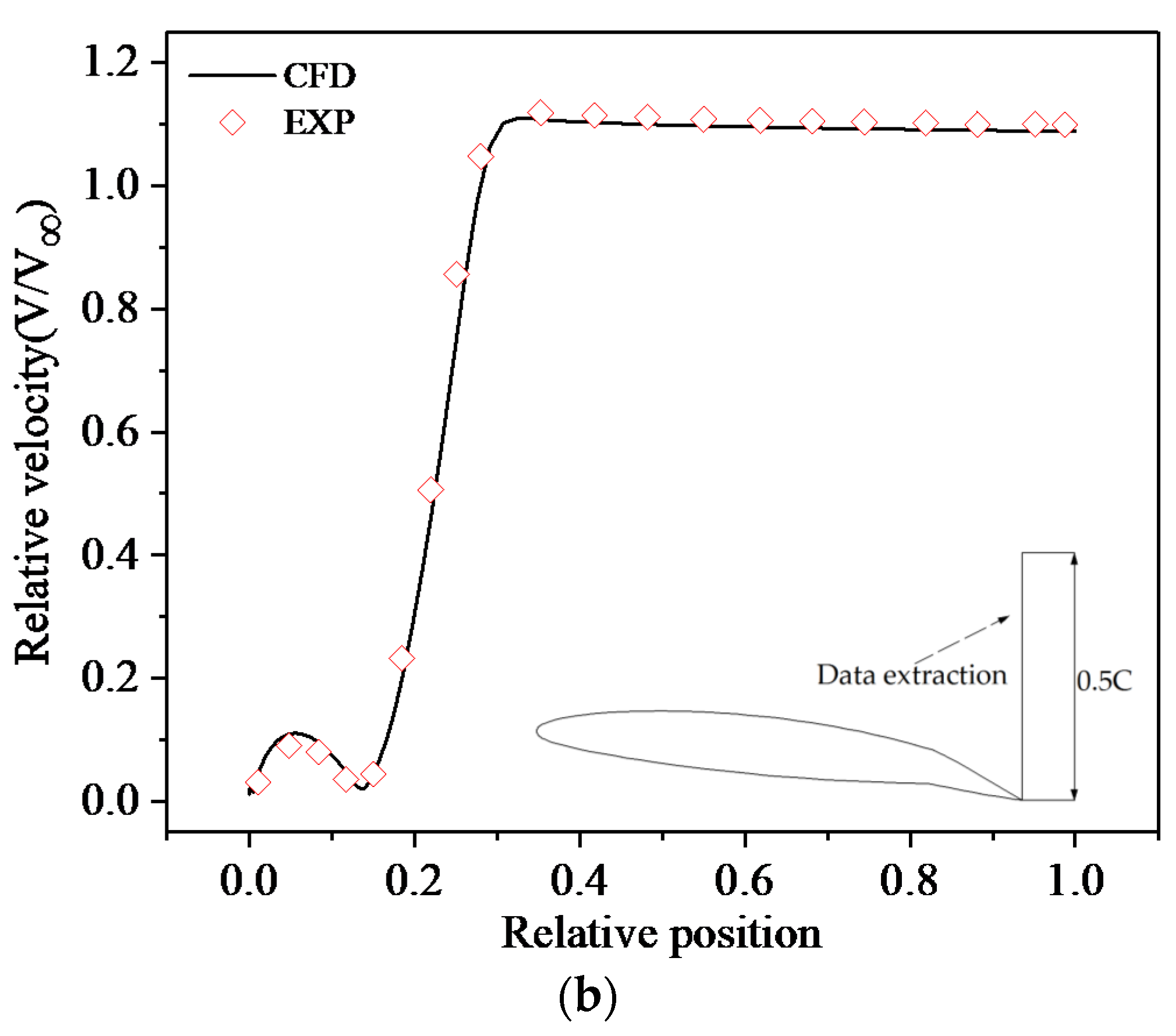



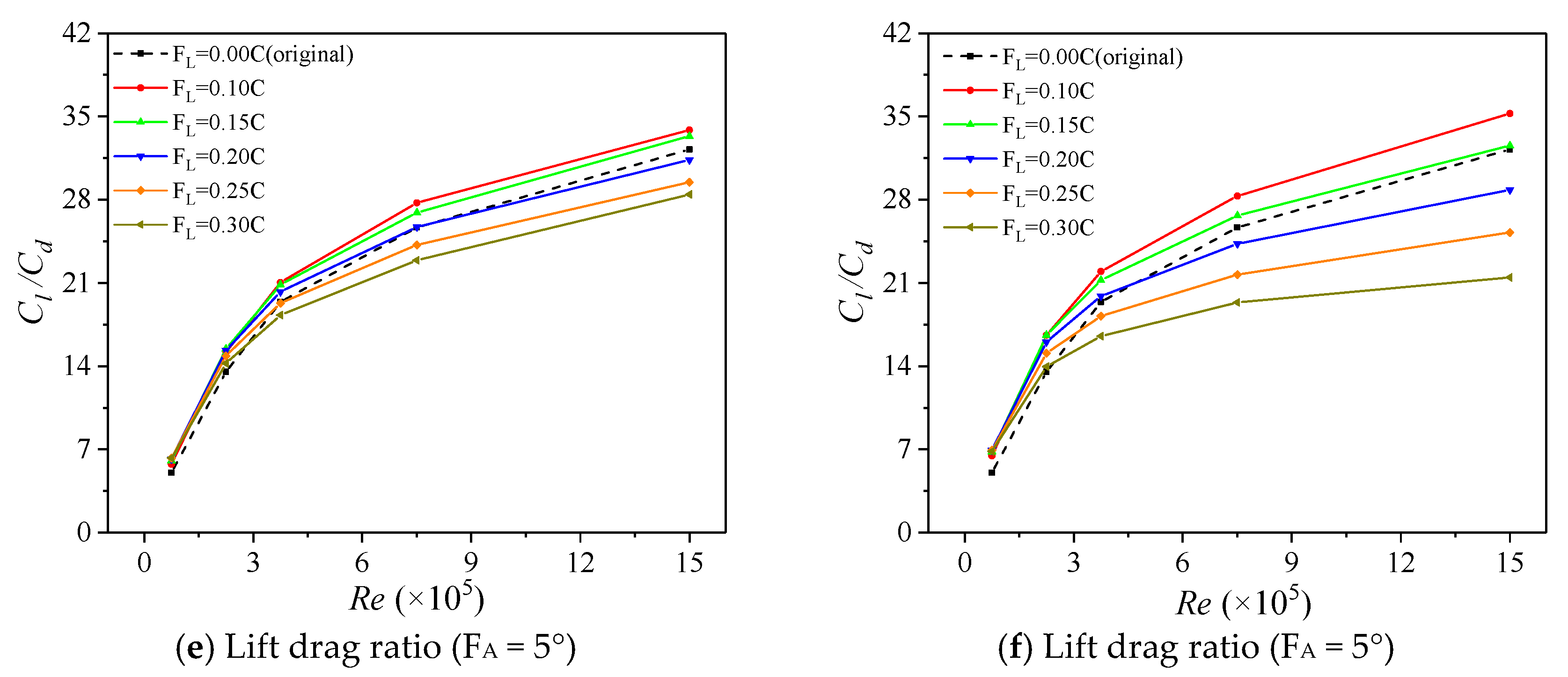
| Type | State | Type | State |
|---|---|---|---|
| Fluid density | 1000 kg·m−3 | 1st layer thickness (mm) | 0.01 |
| Turbulence model | SST k-ω | Growth ratio | 1.1 |
| Turbulence intensity | 2% | Chord (C/mm) | 75 |
| Inlet | Velocity inlet | Flap Length (FL: ×C) | 0, 0.1, 0.15, 0.2, 0.25, 0.3 |
| Outlet | Pressure outlet | Angle of attack (AOA) | 0, 3, 6, 9, 12, 15, 18, 21 |
| Reynolds number (×105) | 0.7, 2.1, 3.5, 7, 15 | Flap Angle (FA) | −10, −5, 0, 5, 10 |
| Number of grids (million) | 0.9 | y+ | ≤1 |
Publisher’s Note: MDPI stays neutral with regard to jurisdictional claims in published maps and institutional affiliations. |
© 2021 by the authors. Licensee MDPI, Basel, Switzerland. This article is an open access article distributed under the terms and conditions of the Creative Commons Attribution (CC BY) license (https://creativecommons.org/licenses/by/4.0/).
Share and Cite
Xiong, P.; Deng, J.; Chen, X. Performance Improvement of Hydrofoil with Biological Characteristics: Tail Fin of a Whale. Processes 2021, 9, 1656. https://doi.org/10.3390/pr9091656
Xiong P, Deng J, Chen X. Performance Improvement of Hydrofoil with Biological Characteristics: Tail Fin of a Whale. Processes. 2021; 9(9):1656. https://doi.org/10.3390/pr9091656
Chicago/Turabian StyleXiong, Pan, Jianghong Deng, and Xinyuan Chen. 2021. "Performance Improvement of Hydrofoil with Biological Characteristics: Tail Fin of a Whale" Processes 9, no. 9: 1656. https://doi.org/10.3390/pr9091656
APA StyleXiong, P., Deng, J., & Chen, X. (2021). Performance Improvement of Hydrofoil with Biological Characteristics: Tail Fin of a Whale. Processes, 9(9), 1656. https://doi.org/10.3390/pr9091656





